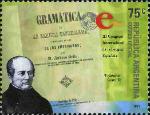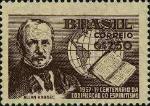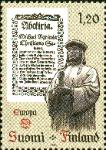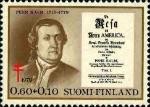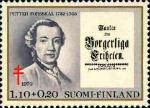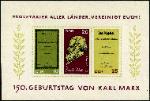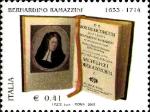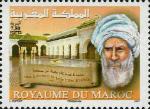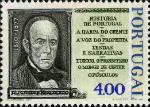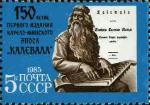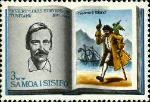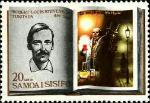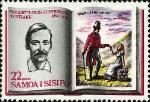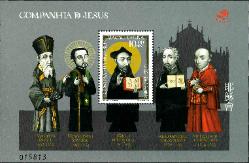| 10e--Authors with Their Books This page is still under construction--please check back again later |
Issued on 6 November 2004 to
commemorate the Third
International Spanish Language
Congress in Rosario, Argentina,
this 75-cent value depicts
Andrés Bello (1781-1865) and
the title-page of his Spanish
grammar for Americans
(Argentina Scott #2305).
commemorate the Third
International Spanish Language
Congress in Rosario, Argentina,
this 75-cent value depicts
Andrés Bello (1781-1865) and
the title-page of his Spanish
grammar for Americans
(Argentina Scott #2305).
This set of three stamps,
which was issued on 30
December 1995, honors
“Famous People” and includes
Leu Sapega (1557-1633), one
of the greatest Belarusian
political figures; K.
Semyanovitch (1600-1651), a
military scholar; and the writer
Simeon Polotzki (1629-
1680), a Belorussian monk
from Polotsk who not only
introduced new forms of
religious literature derived
from Western models, but also
created the first substantial
body of poetry in Russian.
Each notable is pictured near
books, presumably books they
wrote (Belarus Scott #135-137).
which was issued on 30
December 1995, honors
“Famous People” and includes
Leu Sapega (1557-1633), one
of the greatest Belarusian
political figures; K.
Semyanovitch (1600-1651), a
military scholar; and the writer
Simeon Polotzki (1629-
1680), a Belorussian monk
from Polotsk who not only
introduced new forms of
religious literature derived
from Western models, but also
created the first substantial
body of poetry in Russian.
Each notable is pictured near
books, presumably books they
wrote (Belarus Scott #135-137).
Brazil issued this 2.50-cruzeiro
stamp on 18 April 1957; it honors
Allan Kardec, the pen name of
Hippolyte Léon Denizard
Rivail (1804-1869), a teacher
and educator who is known today
as the systematizer of Spiritism.
Kardec laid the foundation of
Spiritism with his five-volume
Codification of Spiritism, or The
Spiritist Pentateuch. The books are
a compilation of questions posed
by Kardec between 1857 and
1868, with the answers allegedly
dictated by Spirits. The books
therefore contain the
fundamental details of the
Spiritism movement, a system of
explaining several phenomena
that have in common the general
belief in the survival of a spirit
after death (Brazil Scott #846).
stamp on 18 April 1957; it honors
Allan Kardec, the pen name of
Hippolyte Léon Denizard
Rivail (1804-1869), a teacher
and educator who is known today
as the systematizer of Spiritism.
Kardec laid the foundation of
Spiritism with his five-volume
Codification of Spiritism, or The
Spiritist Pentateuch. The books are
a compilation of questions posed
by Kardec between 1857 and
1868, with the answers allegedly
dictated by Spirits. The books
therefore contain the
fundamental details of the
Spiritism movement, a system of
explaining several phenomena
that have in common the general
belief in the survival of a spirit
after death (Brazil Scott #846).
| Last edited on 25 June 2013 |
With its Society of Jesus issue of five stamps and a souvenir sheet
(shown here) on 30 November 2006, Macao marked several
anniversaries. The year was the 450th anniversary of the death of
Saint Ignatius of Loyola (1491-1556), founder of the Society of
Jesus; the 500th anniversary of the birth of St. Francis Xavier
(1507-1552), the first Jesuit to reach China and Japan; the 400th
anniversary of the death of Alessandro Valignano (1539-1606),
Provincial and Jesuit Visitor of the East Indies, who defined a strategy
to be followed by the Society of Jesus in China and Japan; and the
490th anniversary of the birth of Melchior Carneiro (1516-1583), the
first bishop of the diocese of Macao. China became a Jesuit
independent province in 1604, with Matteo Ricci (1552-1610) acting
(shown here) on 30 November 2006, Macao marked several
anniversaries. The year was the 450th anniversary of the death of
Saint Ignatius of Loyola (1491-1556), founder of the Society of
Jesus; the 500th anniversary of the birth of St. Francis Xavier
(1507-1552), the first Jesuit to reach China and Japan; the 400th
anniversary of the death of Alessandro Valignano (1539-1606),
Provincial and Jesuit Visitor of the East Indies, who defined a strategy
to be followed by the Society of Jesus in China and Japan; and the
490th anniversary of the birth of Melchior Carneiro (1516-1583), the
first bishop of the diocese of Macao. China became a Jesuit
independent province in 1604, with Matteo Ricci (1552-1610) acting
as its first Superior since 1596. The Society of Jesus emerged during an era of deep religious debate. Thanks to the
vision of Ignatius of Loyola and his companions—a vision that strongly contributed to the reconciliation of the new
ideas within the Catholic Church during the Reformation, the Society of Jesus would soon become a truly universal
religious order. All of these men (including two saints—look for the halos) are commemorated in a set of stamps and
this souvenir sheet. Note than most are holding books. Designed by Victor Hugo Marreiros. Printed in sheets of 20
for Macao Post by Johann Enschedé Security Printers, Haarlem (Macao Scott #1209a).
vision of Ignatius of Loyola and his companions—a vision that strongly contributed to the reconciliation of the new
ideas within the Catholic Church during the Reformation, the Society of Jesus would soon become a truly universal
religious order. All of these men (including two saints—look for the halos) are commemorated in a set of stamps and
this souvenir sheet. Note than most are holding books. Designed by Victor Hugo Marreiros. Printed in sheets of 20
for Macao Post by Johann Enschedé Security Printers, Haarlem (Macao Scott #1209a).
This stamp was issued to
mark the death centenary of
Alexandre Herculano de
Carvalho Araujo (1810-1877),
historian and novelist. The
stamp shows the title page
mark the death centenary of
Alexandre Herculano de
Carvalho Araujo (1810-1877),
historian and novelist. The
stamp shows the title page
from the first volume of his History of Portugal from the
beginning of the monarchy to the end of the reign of
Afonso III, a book written on critical lines and based on
documents, the first volume of which was published in
1846. Serious students in Portugal and abroad welcomed
the book as a historical work of the first rank, for its
evidence of careful research, its able marshaling of facts,
its scholarship and its painful accuracy, while the
sculptural simplicity of the style and the correctness of
the diction have made it a Portuguese classic. (Portugal
Scott #1346).
beginning of the monarchy to the end of the reign of
Afonso III, a book written on critical lines and based on
documents, the first volume of which was published in
1846. Serious students in Portugal and abroad welcomed
the book as a historical work of the first rank, for its
evidence of careful research, its able marshaling of facts,
its scholarship and its painful accuracy, while the
sculptural simplicity of the style and the correctness of
the diction have made it a Portuguese classic. (Portugal
Scott #1346).
To commemorate World Book
Day in 1981, Brazil issued this
stamp depicting Father José
de Santa Rita Durão
(1722-1784), a colonial
Brazilian Neoclassic poet,
Day in 1981, Brazil issued this
stamp depicting Father José
de Santa Rita Durão
(1722-1784), a colonial
Brazilian Neoclassic poet,
orator, and Augustinian friar. After he studied at the
Jesuit College of Rio de Janeiro, he went to Europe,
where he became an Augustinian priest. He worked in
Portugal as a librarian for 20 years, also traveling to
Spain and France. The center of the stamp shows the
title page of his epic poem, Caramuru (1781). Based on
the life of the famous Portuguese sailor, Diego Álvares
Correia (a.k.a. “Caramuru,” which is Tupi for the “Son of
the Thunder”), it is a tribute to Brazil, to where Durão
would never return. He would die in Portugal in 1784.
Diego Álvares Correia is shown to the right on the
stamp (Brazil Scott #1768).
Jesuit College of Rio de Janeiro, he went to Europe,
where he became an Augustinian priest. He worked in
Portugal as a librarian for 20 years, also traveling to
Spain and France. The center of the stamp shows the
title page of his epic poem, Caramuru (1781). Based on
the life of the famous Portuguese sailor, Diego Álvares
Correia (a.k.a. “Caramuru,” which is Tupi for the “Son of
the Thunder”), it is a tribute to Brazil, to where Durão
would never return. He would die in Portugal in 1784.
Diego Álvares Correia is shown to the right on the
stamp (Brazil Scott #1768).
Juan Ignacio Molina (1740-
1829), was a Spanish, later
Chilean, Jesuit priest, naturalist, historian,
botanist, ornithologist,
and geographer. Molina
expressed support for a
1829), was a Spanish, later
Chilean, Jesuit priest, naturalist, historian,
botanist, ornithologist,
and geographer. Molina
expressed support for a
sedimentary origin of basalt in Ensayo Sobre la Historia Natural de Chile (1782) [Essay on the Natural History of Chile], featured on a shelf of background books on this stamp, where he pointed out the fact that basalt occurred both in the Andes and on coast of Chile, where there were no signs of eruption; he believed basalt was a form of compacted slate with vesicles. As early as 1787 Molina mentioned the possibility of South America being populated from South Asia through the “infinite island chains“ of the Pacific, while North America could have been populated from Siberia (Chile #C282).
Croatia included Ivan Lucic (1604-1679) among a set commemorating famous Croats. Lucic was a Venetian Dalmatian historian. His greatest work, De Regno Dalmatiae et Croatiae [On the Kingdom of Dalmatia and Croatia], the title-page of which serves as background on this stamp, includes valuable
historical sources, a bibliography, and six historical
maps (Croatia #546).
maps (Croatia #546).
